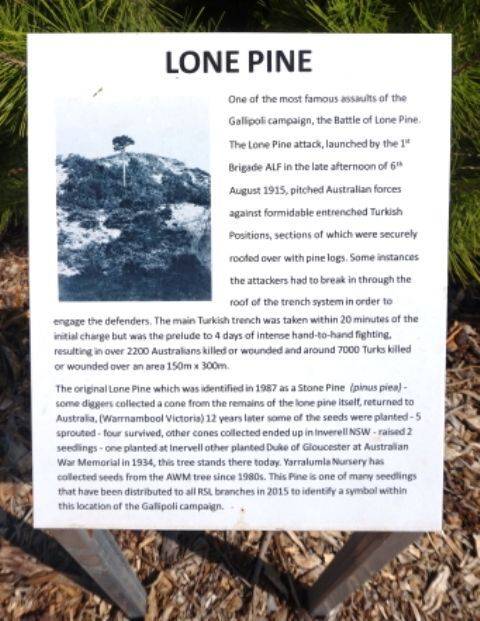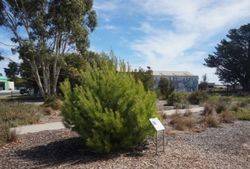
Home » Themes » Conflict » World War One
Lone PinePrint Page 
The Pine tree commemorates those who served in World War One. Pines which are planted as a memorial to the Australian and New Zealand soldiers who fought in Gallipoli are also known as "Lone Pines" or "Gallipoli Pines", referencing the original tree.
The Lone Pine was the name given to a solitary tree on the Gallipoli Peninsula in Turkey, which marked the site of the Battle of Lone Pine in 1915 during World War One and it was the sole survivor of a group of trees that had been cut down by Turkish soldiers who had used the timber and branches to cover their trenches.
The tree was obliterated during the battle; however, pine cones that had remained attached to the cut branches over the trenches were retrieved by two Australian soldiers and brought home to Australia. Private Thomas Keith McDowell, a soldier of the 23rd Battalion brought a pine cone from the battle site back to Australia, and many years later seeds from the cone were planted by his wife's aunt Emma Gray of Grassmere, near Warrnambool, Victoria and five seedlings emerged, with four surviving. These seedlings were planted in four different locations in Victoria: Wattle Park (May 8, 1933), the Shrine of Remembrance in Melbourne (June 11, 1933), the Soldiers Memorial Hall at The Sisters near Terang (June 18, 1933) and Warrnambool Botanic Gardens (January 23, 1934).
Another soldier, Lance Corporal Benjamin Smith from the 3rd Battalion, also retrieved a cone and sent it back to his mother (Mrs McMullen) in Australia, who had lost another son at the battle. Seeds from the cone were planted by Mrs McMullen in 1928, from which two seedlings were raised. One was presented to her home town of Inverell (New South Wales) and the other was forwarded to Canberra where it was planted by Prince Henry, Duke of Gloucester at the Australian War Memorial in October 1934.
The Shrine of Remembrance's lone pine was felled in August 2012 and the timber used as part of a remembrance project, after a disease known as Diplodia pinea or blue stains fungus as it commonly called killed it.
Melbourne Legacy and the Yarralumla Nursery in Canberra have grown seedlings sourced from the trees at the Shrine of Remembrance and the Australian War Memorial respectively, which they have presented to schools as well as ex-service and other organisations throughout Australia.
Location
| Address: | Princes Highway, Meningie Memorial Park, Meningie, 5264 |
|---|---|
| State: | SA |
| Area: | AUS |
| GPS Coordinates: | Lat: -35.687562 Long: 139.338075 Note: GPS Coordinates are approximate. |
Details
| Monument Type: | Tree |
|---|---|
| Monument Theme: | Conflict |
| Sub-Theme: | WW1 |
| Actual Event Start Date: | 04-August-1914 |
| Actual Event End Date: | 28-June-1919 |
Dedication
LONE PINE
One of the most famous assaults of the Gallipoli campaign, the Battle of Lone Pine. The Lone Pine attack, launched by the 1st Brigade AIF in the late afternoon of 6th August 1915, pitched Australian forces against formidable entrenched Turkish positions, sections of which were securely roofed over with pine logs. Some instances the attackers had to break in through the roof of the trench system in order to engage the defenders. The main Turkish trench was taken within 20 minutes of the initial charge but was the prelude to 4 days of intense hand-to-hand fighting, resulting in over 2200 Australians killed or wounded and around 7000 Turks killed or wounded over an area 150m x 300m.
The original Lone Pine which was identified in 1987 as a Stone Pine (Pinus piea (sic)) - some diggers collected a cone from the remains of the lone pine itself, returned it to Australia, (Warnnambool Victoria) 12 years later some of the seeds were planted - 5 sprouted - four survived, other cones collected ended up in Inverell NSW - raised 2 seedlings - one planted at Inverell other planted Duke of Gloucester at Australian War Memorial in 1934, this tree stands there today. Yarralumla Nursery has collected seeds from the AWM tree since 1980s. This Pine is one of many seedlings that have been distributed to all RSL branches in 2015 to identify a symbol within the location of the Gallipoli campaign.






